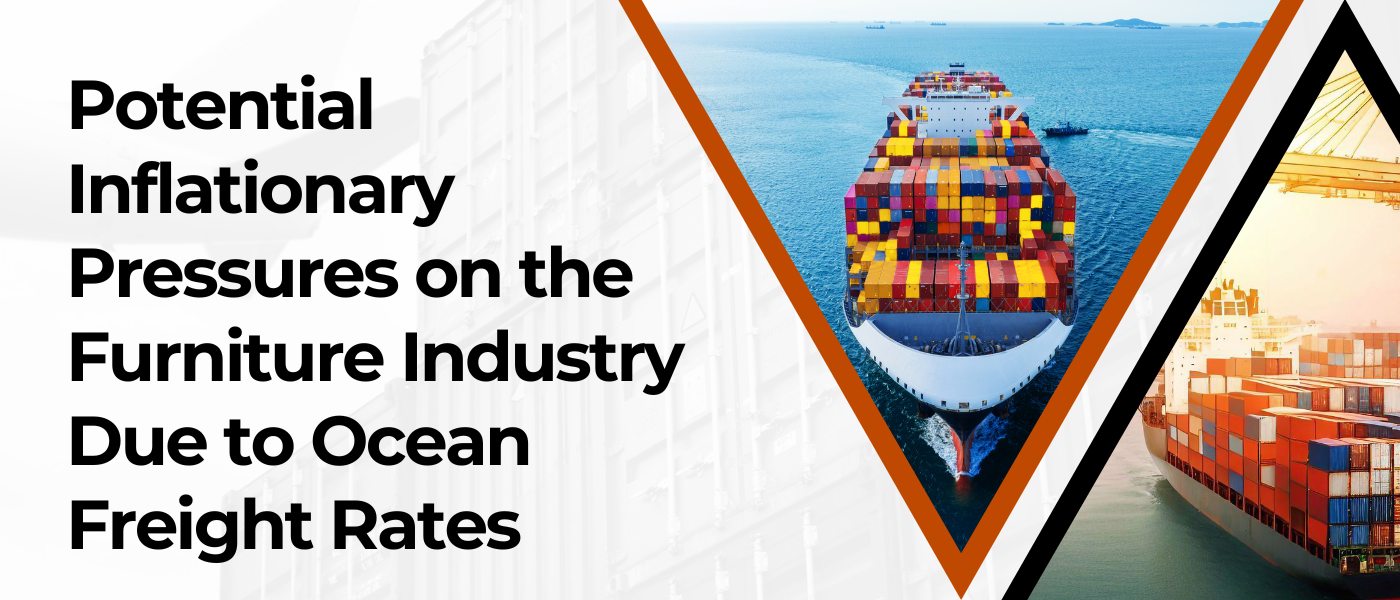Potential Inflationary Pressures on the Furniture Industry Due to Ocean Freight Rates
Potential Inflationary Pressures on the Furniture Industry Due to Ocean Freight Rates

Inflation is a pressing concern for many industries, and the furniture sector is no exception. One significant contributor to potential inflationary pressures is the fluctuation in ocean freight rates. Recent geopolitical and economic developments have exacerbated these pressures, particularly for shipments from China to the U.S. East Coast. This blog will explore how the Red Sea crisis, peak season dynamics, political uncertainties, and labor contract negotiations are driving up ocean freight rates and, consequently, impacting the cost of furniture.
The Red Sea Crisis and Its Ripple Effects
The Red Sea crisis has created a significant bottleneck in global shipping routes. Due to increased instability and threats in the region, many carriers have had to reroute their vessels around the Cape of Good Hope. This detour adds an additional 2-3 weeks of transit time each way, totaling an extra 5-6 weeks for a round trip. The implications for shipping logistics are profound.
To maintain a weekly sailing schedule from China to the U.S. East Coast, carriers need to deploy five additional vessels to compensate for the extended travel time. However, most carriers do not possess the surplus capacity required. As a result, there has been an increase in blank sailings, where scheduled sailings are canceled due to a lack of available vessels. This disruption reduces the overall supply of shipping slots, pushing up freight rates due to heightened demand and limited availability.
Peak Season and Increased Demand
Summer marks the traditional peak season for most retailers, including those in the furniture industry. Retailers begin ramping up their volumes to prepare for the holiday season, a period characterized by high consumer spending and increased demand for furniture and home decor. This seasonal surge places additional strain on already stretched supply chains.
As retailers scramble to secure shipping space to ensure timely delivery of their goods, they drive up the demand for ocean freight services. With the supply of available vessels already constrained due to the Red Sea crisis, the competition for shipping slots intensifies. This heightened demand during the peak season inevitably leads to higher freight rates, contributing to increased costs for importing furniture.
Political Uncertainties and Tariff Concerns
The political landscape also plays a crucial role in shaping ocean freight rates and, by extension, furniture prices. Speculation about a potential Trump presidency has generated significant anxiety among exporters and importers. Trump has stated his intention to increase tariffs on Chinese goods from 25% to 65%, compounding the existing duty rates. This threat of a substantial tariff hike has prompted many importers to stock up on inventories preemptively, hoping to mitigate future costs.
Importers with the capacity to do so are accelerating their shipping schedules to avoid potential tariff increases. This rush to import goods before any tariff changes further exacerbates the demand for ocean freight services. The increased volume of shipments, driven by political uncertainties, adds to the strain on shipping capacity and contributes to rising freight rates.
Labor Contract Negotiations and Potential Strikes
Another factor influencing ocean freight rates is the impending expiration of the International Longshoremen’s Association (ILA) contract for East Coast ports. The possibility of a port lockout due to a potential strike has prompted many importers to expedite their shipments to avoid disruptions. The fear of a strike-induced port shutdown has led to a surge in shipping volumes as companies strive to get their goods through the ports before any labor actions can occur.
This rush to move goods ahead of a potential strike puts additional pressure on the already constrained shipping capacity. As importers compete for limited shipping slots, freight rates are driven up even further. The uncertainty surrounding labor contract negotiations adds another layer of complexity to the shipping landscape, contributing to inflationary pressures on the cost of importing furniture.
Conclusion
The convergence of these factors—geopolitical crises, seasonal demand spikes, political uncertainties, and labor contract negotiations—creates a perfect storm for inflationary pressures on ocean freight rates. As freight rates rise, so too do the costs for importing furniture. These increased costs inevitably trickle down to consumers, leading to higher prices for furniture and home goods.
For retailers and consumers alike, understanding the underlying causes of these cost increases is crucial. By anticipating potential disruptions and strategically managing inventory and shipping schedules, businesses can better navigate the challenging landscape of global trade. However, without significant changes in the current dynamics, the furniture industry will likely continue to face upward pressure on prices, driven by the complex interplay of these global factors.




